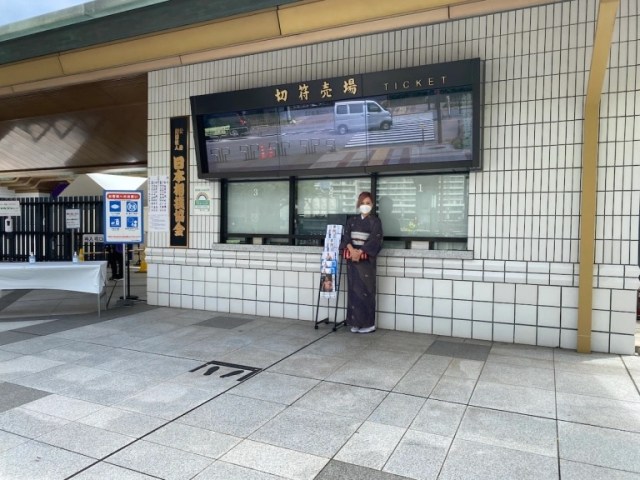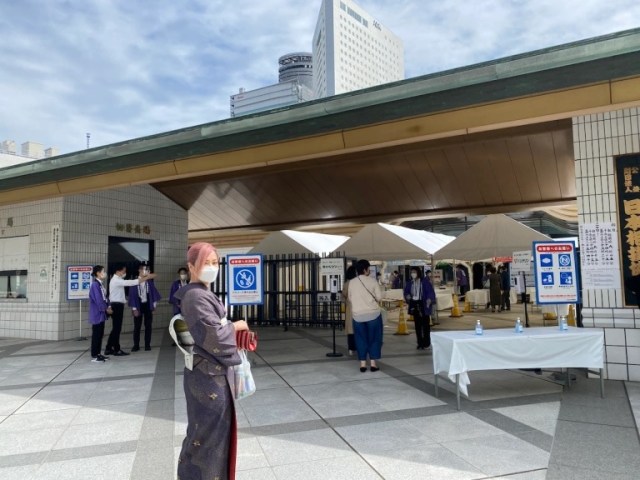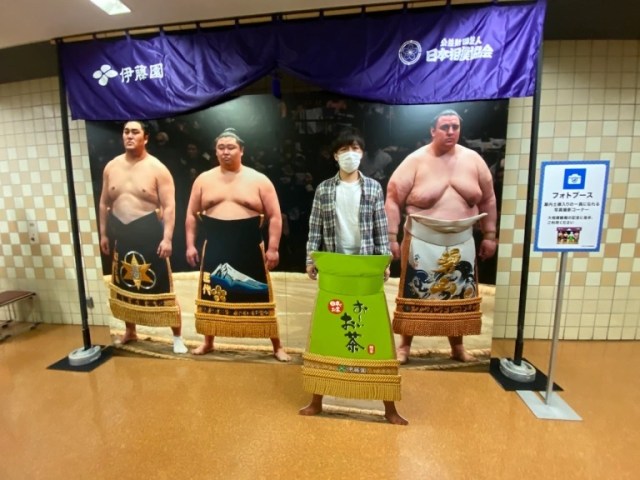
Our sumo beginner gets a lesson from a kimono-clad veteran.
Sumo is often considered to be Japan’s national sport, in light of its long history and many aspects tied to Japanese cultural and religious beliefs. The side effect of all that, though, is that a lot of younger people in Japan haven’t ever been to watch sumo in person, since the layers of tradition can make it seem intimidating and unfamiliar.
Our Japanese-language reporter Takashi Harada isn’t a complete sumo neophyte, but he’s pretty close. In his whole life, he’s been to exactly one sumo tournament, back when he was an elementary school student in Fukuoka Prefecture, and aside from that his only experience with the sport is catching a few random glimpses of matches that his grandfather used to watch on TV in their home.
But recently Takashi has been wanting to learn more about the sport, and a chance to do just that fell into his lap when another member of our writing team, Ikuna Kamezawa, offered him a spare ticket she had to the September grand sumo tournament held in Tokyo’s Ryogoku district.
▼ Ryogoku Station

Takashi remembers his grandfather watching sumo in the evenings, so he was surprised when Ikuna told him to get to Ryogoku well before noon. Even before he was out of the station, Takashi was wrapped in the sumo atmosphere, with portraits of great wrestlers from the past adorning Ryogoku Station’s walls.

A sign asking train travelers to wear masks and disinfect their hands also employed sumo style…

…and even the attached 7-Eleven has a sumo sculpture and old-school lattice-like storefront.

Kokugikan, Tokyo’s sumo stadium, is right across the street from the station. As you approach the entrance on tournament days, you’ll see flags, called noborihata, bearing the names of the sport’s top stars.


As promised, Ikuna was waiting outside the entrance for Takashi, and she was definitely dressed up for the occasion.


While casual attire is perfectly acceptable for Kokugikan, Ikuna is a diehard sumo fan. Being born in rural Shimane Prefecture, there weren’t any major tournaments held near her home, so she used to take the overnight bus to Fukuoka to see the big-name wrestlers in action. Speaking of which…

…Takashi found himself on the receiving end of Ikuna’s glaring gaze when he failed to react to the rack of pamphlets she was standing next to.

“That’s Kotoshogiku! Don’t you know who he is? Not only is he from Fukuoka, just like you, but the two of you are the same age! You could have been classmates. He just retired after the last tournament…so you mean you weren’t cheering for him for his whole career?”

Takashi sheepishly informed Ikuna that no, he hadn’t ever heard of Kotoshogiku. Then again, there are a lot of sumo wrestlers that Takashi has never heard of, which is why he was here, Ikuna remembered, so she decided to cut him some slack and they headed inside.



Even without being a sumo fan, though, Takashi knew he was on hallowed ground, and he felt a wave of excitement as he passed through the threshold and saw the trophies and awards on display.

Before checking out the rest of the facility, though, they made their way to their seats.

Though it’s Japan’s premier sumo venue, Kokugikan isn’t as big as, say, a pro basketball arena, and the distances/sightlines mean you get a pretty nice view of the ring even if you’re not in the first rows of seats.
▼ Speaking of “seats,” the closer sections, like where Takashi is sitting here, have traditional flat floors with cushions, while the ones further back and on the second floor have chairs.

As they sat down, Takashi realized why Ikuna had told him to come to Ryogoku so early: the grand sumo tournament is an all-day event! Taking place over the course of 14 consecutive days, the morning matches are between lower-division wrestlers, the afternoon the mid-rank, and the evening is when the top-tier talent steps into the ring. Morning matches start around 9 a.m., and the last ones finish around six. Tickets start at about 3,500 yen (US$24.50), which isn’t a bad price at all for a whole day of live pro sports entertainment.
While some people skip the lower-rank bouts, showing up for the a.m. matches lets you enjoy them in a much less-crowded atmosphere, and Takashi was immediately impressed by two things that he hadn’t been able to fully appreciate just watching on TV.
First, though sumo is a competition among very large competitors, the ring itself is surprisingly compact. It’s just 4.55 meters (14.9 feet) in diameter, shorter than the length of most boxing rings, and since stepping or being forced outside the ring results in a loss for a sumo wrestler, it takes a lot of agility to stay inside the circle.
The other awesome thing about watching sumo wrestling in-person? The sound. The cracks, thuds, and crunches as the wrestlers slap, slam, and shake each other are all more impactful when they’re echoing off the walls and ceiling of Kokugikan, rather than being facsimiled by your TV’s speakers.

During a lull in the action, Ikuna took Takashi to see the rest of the arena, including its various trick art photo spots.




They also decided to grab lunch before the higher-rank matches started in the afternoon. Luckily, Kokugikan has multiple places to get a bite to eat, starting with this takeout counter that sells snacks and bento boxed lunches.

There’s also a cafeteria located in the basement level…

…which is where Takashi got a bowl of chanko nabe hot pot for 500 yen (US$3.50)…

…and a 1,200-yen bento.


The chanko is especially appropriate, as the hearty stew is the traditional meal served at sumo stables, as the wrestlers’ training facility dormitories are called. You might think that means it’s incredibly calorie-intensive, but chanko is actually a pretty healthy mix of meat and vegetables, and its connection to sumo is more about tradition and the ease of it being easier to make a huge quantity of stew than most other kinds of cooking.
▼ The cafeteria

After lunch, Ikuna took Takashi up to the first-floor terrace area, which looks out onto the path the wrestlers walk on when entering the stadium.

The railing has been put in place since the start of the pandemic, but you used to be able to get even closer to the wrestlers, so it’s a safe bet that the barricade will eventually come down.

With the higher-ranked matches starting, Takashi and Ikuna headed back to their seats, where she whipped out her program.

The daily sumo tournament program is called a hoshiorihyo, which translates literally as “star-taking chart.” Instead of stars, though, you’ll find circles by the name of each listed wrestler. These indicate their record in the tournament so far, with a white circle standing for a win and a black circle a loss. So, for example, if the hoshiorihyo for a wrestler looks like this, 〇〇●●〇, it means he won his bouts on Days 1 and 2 of the tournament, lost on Days 3 and 4, and won again on Day 5 (wrestlers each fight one match per day).

The program also lists the wrestlers’ height, weight, and hometown, so even someone who doesn’t regularly keep up with the sport, like Takashi, can get a sense of story and pick out who they want to cheer for. On the subject of height/weight, Ikuna pointed out that it’s a common misconception that the biggest wrestler always wins, as power is just one factor, along with skill, speed, experience, and tenacity, that goes into determining who wins and loses each match.

As the higher-ranking wrestlers start showing up, so too do the bigger crowds of fans.

Aside from the enhanced level of skill and strength in the top division, the thing that struck Takashi the most was the intense, concentrated anticipation at the start of each bout. Each match starts with the opponents silently staring at each other, and the hush that came over the crowd, with every eye in the house focused on the center of the ring, was another awesome feeling you can’t really get from watching the sport on TV.
When the day’s matches were all done, the sun had gone down. Ikuna and Takashi took the scenic route back to the station, as she guided him past Ekoin Temple, where the graves of several prominent sumo wrestlers are located…

…as well as a couple of sumo stables located in the neighborhood.

Looking back on the matches they’d seen, Takashi realized that the one that had left the deepest impression on him was actually one of the mid-rank ones. Sumo works on a promotion/demotion system; win consistently enough in your rank, and you move up to the group above, but if your performance slips enough, you get sent down. The latter is what happened with Asanoyama, who was demoted after sitting out a tournament entirely. Since his demotion wasn’t based on losing matches, he’s been thrashing his opponents at the lower rank as he rushes to get back to his former position. On Takashi’s day at Kokugikan, everyone expected Asanoyama to easily defeat his opponent, a less-celebrated wrestler from Osaka named Yuma. As the match started, it certainly looked like that was how things were going to go, but Yuma refused to give up, fought with all of his strength, and came away with the upset victory.

So while he still doesn’t know nearly as much about sumo as Ikuna does, Takashi now considers himself a sumo fan, and a Yuma fan too.
Photos ©SoraNews24
● Want to hear about SoraNews24’s latest articles as soon as they’re published? Follow us on Facebook and Twitter!

No hay comentarios:
Publicar un comentario